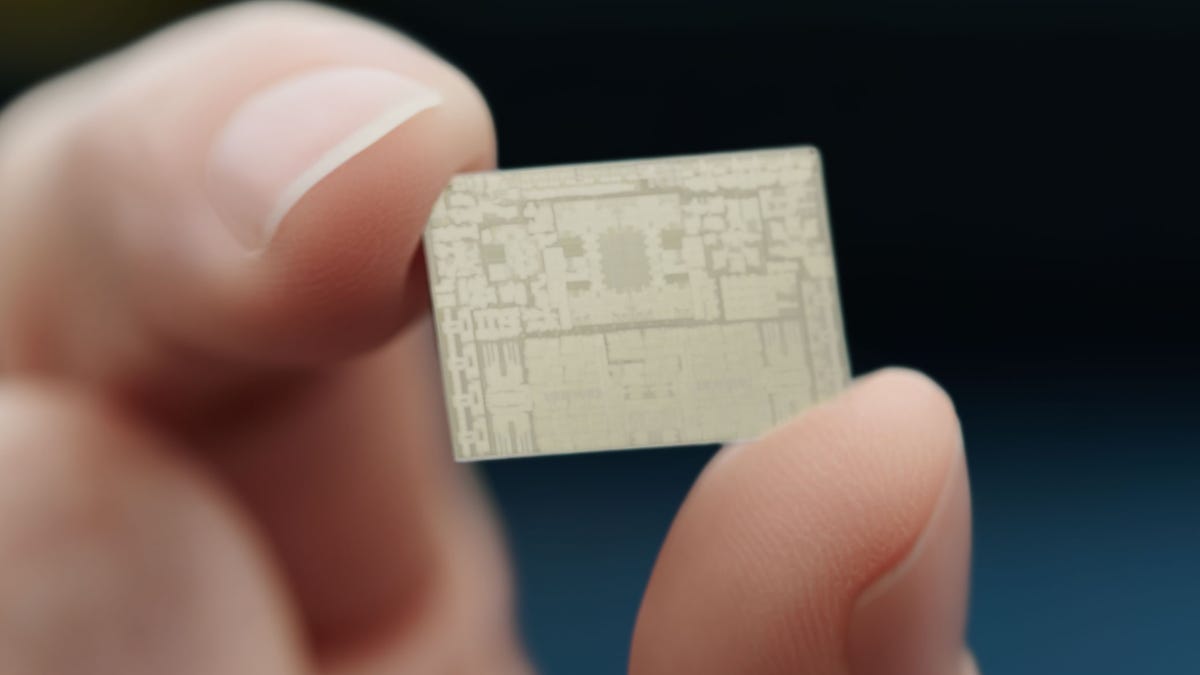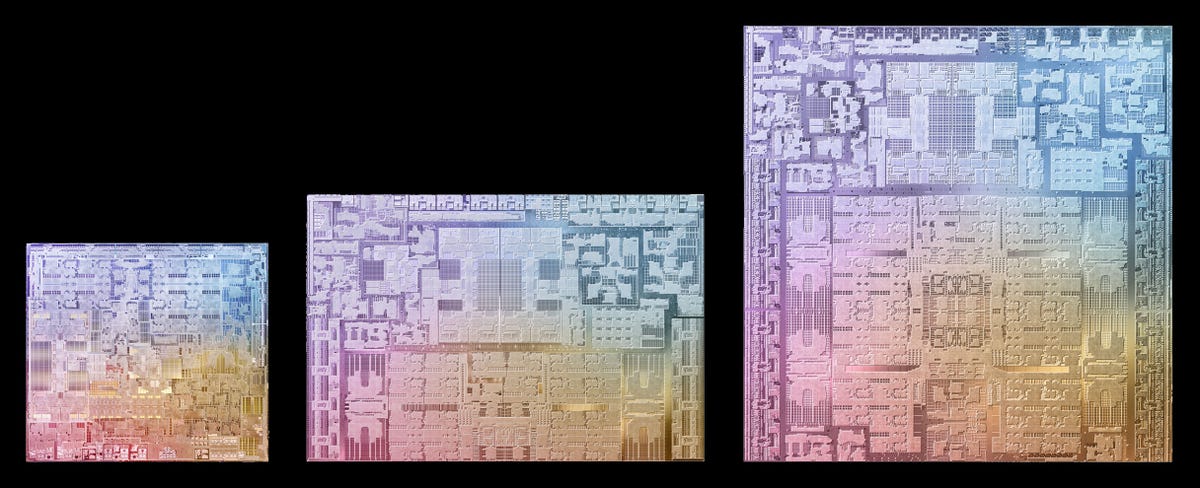
Apple’s M2 Pro processor has more than 40 billion transistors.
Apple
With its new M2 Pro and M2 Max processors, Apple’s is repeating a formula that worked well for its earlier M1 designs. By bolting some extra circuitry onto an efficient foundation, Apple can offer a significant upgrade to its new M2-based MacBook Pro laptops without a chip overhaul.
Apple introduced its first in-house Mac processor, the M1, for MacBook Air laptops that arrived in 2020. The M1 already took advantage of chip design work for the iPhone’s A-series chips, but Apple beefed up the M1 with more processing cores to make the M1 Pro and M1 Max in late 2021 for higher-end MacBook Pro laptops. Then in 2022, it glued two M1 Max chips together into the top-end M1 Ultra.
Now, Apple is headed the same route with the M2, which debuted in 2022 and now is joined by the M2 Pro and M2 Max for new MacBook Pro models. If history continues to repeat itself, we could see a Mac Pro based on a hulking M2 Ultra processor in the coming months.
The chips’ speed boost over M1 equivalents that debuted 15 months ago is significant — 20% at least by Apple’s measurements. Owners of year-old M1-generation MacBook Pro laptops to upgrade. But for those using older Macs based on the older Intel chips Apple ejected from its product line, the speed boost and better battery life could be much more compelling.
“These new Macs should help entice moving off Intel to M series in 23,” Creative Strategies analyst Ben Bajarin said in a tweet Tuesday. His firm estimates 42% of Mac owners in the US are still using Intel-based models, and the fraction is probably higher worldwide.
Apple didn’t respond to requests for comment. Intel declined to comment.
How did Apple speed up the M2 Pro and M2 Max chips?
The M2 Pro and Max chips are faster thanks to new designs for the chip’s central processing unit cores for general computation and graphics processing unit cores for handling graphics tasks and some other jobs that work on GPUs. The new designs also have more CPUs, GPUs and another core type for accelerating artificial intelligence tasks, which Apple calls its Neural Engine.
The M1 Pro has eight or 10 CPU cores, depending on configuration, and the M1 Max has 10. The M2 Pro has 10 or 12, and the M2 Max has 12. The M2 generation is 20% faster, Apple said, citing unspecified but industry standard speed tests.
CPU performance is the foundation of everything a processor does, and all the M-series Pro and Max models employ four power-efficient CPU cores for better battery life. The remaining CPU cores offer higher performance cores for more important work. Intel also has adopted this approach, pioneered for smartphones.
For GPUs, used for tasks like playing games and editing photos and videos, the M1 Pro came with 14 or 16 cores and the M1 Max with 16 to 32 cores. The M2 Pro boosts that to 16 or 19 GPU cores, and the M2 Max to 30 or 38. The M2 GPU performance is 30% faster, though part of the speed boost comes from better cache memory on the chip, Apple said.
The neural engine has 16 cores on both M1 and M2 generations, but Apple boasts its AI performance is 40% faster with the new chips. AI software is just getting started, but it’s used in important jobs like some Adobe Photoshop image editing, and you can expect that AI performance to become more and more important as more developers figure it out.


Apple’s M2, M2 Pro and M2 Max processors have 20 billion, 40 billion and 67 billion transistors, respectively.
Apple; images compiled by Stephen Shankland/CNET
Speed boosts compared to Intel-based Macs, which use years-old Intel chips, are more notable. The M2 Pro is 2.5 times faster at compiling software and 80% faster at Photoshop image editing compared with an older 16-inch MacBook with an Intel i9 processor, Apple said. As for the M2 Max, it’s twice fast at video color adjustments and six times faster at Da Vinci Resolve video editing.
Some of the speed boosts on the M2 Max comes from faster memory transfer, doubling to 400 megabytes per second, which helps with data-heavy chores like video editing and 3D modeling. The M2 Max new models also accommodate up to 96GB of memory, up from 64GB on the M1 Max.
How are the M2 Pro and M2 Max chips built?
As with all Apple-designed processors for the last few years, Taiwan Semiconductor Manufacturing Co. (TSMC) builds the chips.
As with the M2, the M2 Pro and Max are built with a second-generation 5-nanometer manufacturing process. (A nanometer is a billionth of a meter, and chip manufacturing processes with lower nanometers refer to more advanced manufacturing processes. However, for years now, the numbers have been mere labels of convenience, not actual measurements signifying actual miniaturization progress.)
New manufacturing processes shrink chips’ fundamental electronic elements, called transistors, although that miniaturization is harder these days. That permits more circuitry on a chip. The transistor tally increased from 33.7 billion in the M1 Pro to 40 billion in the M2 Pro; the Max models increased from 57 billion to 67 billion.
TSMC has begun mass product manufacturing on a newer 3 nanometer (3nm) process. Expect that to be used for future iPhone, iPad and Mac processors, a move that should permit even more transistors.
